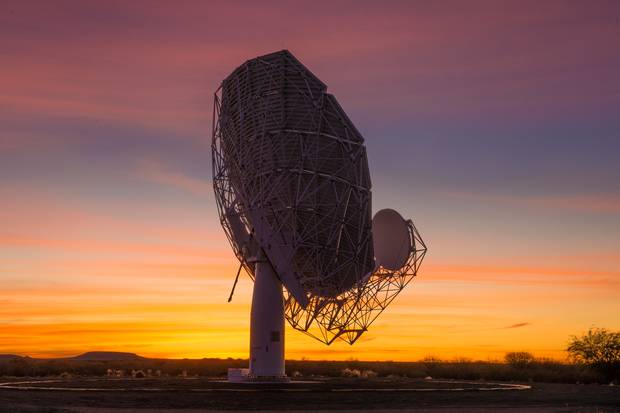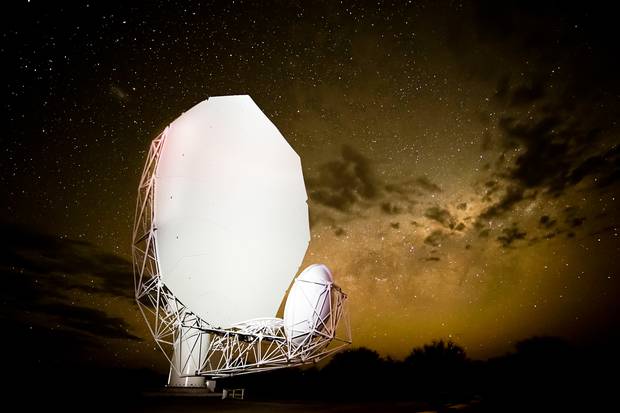In the desolate rocky plains of the Great Karoo, the dangers are endless. Scorpions and puff adders are underfoot. The harsh sun beats down, interrupted only by occasional lightning storms. Temperatures range from stifling heat to freezing cold.
But at night, in the vast empty darkness, the stars are impossibly bright and clear. And it is the stars that have lured a Canadian-backed project to build the world's most powerful radio telescope, with the potential to unlock the deepest secrets of the universe.
For the engineers who are now assembling the telescope in this forbidding landscape, the wind whipping down from the Karoo hills is one of the main worries. Gusts of wind can flip over the giant 13.5-metre-wide dish antennas that form the telescope, so construction is halted as soon as the wind rises.
Yet, the biggest threats are invisible: signals from a cellphone or laptop, emitting enough interference to destroy a day of data from the antennas. To combat this hazard, electronic devices are banned for many kilometres around the site, or kept in underground bunkers behind heavily shielded doors.
The challenges of this pioneering telescope project are extraordinary, but the payoff will be spectacular. The sprawling collection of radio antennas, dubbed the Square Kilometre Array (SKA) because of an early estimate of the size of their collecting surface, could some day find clues to the origins of the universe, the forces that create planets, the nature of dark matter, and the mysteries of possible life in other galaxies.
Like the thousands of receptors in the compound eye of a fly, the project will build its image of the universe from thousands of futuristic antennas, resembling satellite dishes, which will be electronically combined with the help of Canadian technology.
The South African antennas, although still in an early precursor phase, have already discovered more than 1,300 galaxies in a patch of sky where only 70 were previously known to exist. The images stunned astronomers around the world when they were revealed in July.
The full telescope, to be completed by 2024, will be physically divided between South Africa and Australia. But eight other countries, including Canada, will be key partners in the consortium that supports the $2-billion (U.S.) project.
Negotiations among the consortium members, now under way, will set up a council to determine the size of the financial and technological investments by Canada and the other partners. Canada has some of the world's leading expertise in the supercomputers and correlators that will be crucial to the telescope project.
Here in the remote Karoo flatland, sheep farmers and townsfolk are wary of the project, fearing the potential expropriation of their land and the silencing of their telecommunications. Across a vast swath of 132,000 hectares of farmland, a traditional way of life could be lost, and some farmers are skeptical of whether the science-related jobs will be enough to replace it. "Precious agricultural land is under threat," says a group called Save the Karoo.
Yet, the project's benefits are huge. The telescope will be far more sensitive than anything else in existence, allowing far fainter signals to be analyzed.
"The most profound questions that a philosopher might ask are: 'What is the universe made of' and 'Are we alone?'" said Bryan Gaensler, the Canadian SKA science director.
"And the SKA is aiming to answer both of those questions – as well as others, like 'how did everything begin, how will it end.' These are all really deep questions that people have been asking for centuries, and nobody ever thought there would be answers to them," Mr. Gaensler told The Globe and Mail in an interview.
"We'll be able to watch planets form, and then understand if there's life on them. It's exciting. When I started to see the preliminary images, I was just blown away."
Those first images were produced from just 16 of the planned 64 antennas in the SKA's first phase, known as MeerKAT. (The name is derived from an earlier precursor, the Karoo Array Telescope, with a nod to the popular African desert mammal and the Afrikaans word for "more.")
The Globe was recently allowed to visit the guarded MeerKAT site, at the end of a dusty, 90-kilometre drive from the nearest town. Road signs warned of wandering sheep, but there were few signs of life, aside from stony fields of scrub bush and cactus and the occasional lonely farm building.
Watch: A flyover view of the South African array
Engineers disclosed that they have now erected 34 antennas and are hoping to finish the 64th antenna by October, 2017. Many of the gleaming white antennas are already linked into the computers. Their cooling systems are humming in the mid-day heat, their wind detectors are monitoring the breezes, and there is a quiet whirring noise as the giant dishes are adjusted to focus on a new spot in the sky.
The antennas here will produce such an overwhelming tsunami of Big Data that powerful supercomputers will be needed to process it. Not far from the antennas is an underground bunker, where data processing computers will be housed in so-called Faraday cages, behind sliding metal doors, to prevent them from emitting radio interference. The data flow is so massive that it is compressed here, before being transmitted to research centres for analysis.
In a nearby dormitory for the project's staff, the house rules say: "Personal electronic devices may only be used in shielded rooms." Red and black "danger" signs are posted on the walls, warning: "No bluetooth, no cellphones, no wifi. Your radio signals will damage our equipment."
Even ordinary gasoline-powered vehicles are barred from the site, because their spark plugs can cause interference. Only diesel vehicles are used, to protect the precious data arriving from the dishes.
"In the old days, the cost of the telescope was the metal beams, but these days there's a recognition that the supercomputer attached to the telescope is what creates the magic and the potential for discovery," Mr. Gaensler said.
"The philosophy now is that the computer is the telescope. It's a whole new way of doing science. It's not about getting the sharpest, prettiest picture – it's about dealing with incredible torrents of data and finding the needles in the haystacks."
The computers will be crucial because the SKA will generate data volumes that can be measured in exabytes (one billion gigabytes). It will be bigger than the current data rate of the entire Internet.
"It's a big challenge, because we're pushing into realms of processing terrain that we haven't seen before," said Sean Dougherty, director of the Dominion Radio Astrophysical Observatory in Penticton, B.C.
"We've only visited it for very brief moments in experiments like the Large Hadron Collider. That's quite different from the model of the SKA, where data-taking will go over many hours, so the volumes of data are going to be unprecedented."

Canadian-designed supercomputers will help the telescope generate images by combining the signals from the antennas.
SKA SA
Unlike optical telescopes, a radio telescope can peer through the thick layers of dust surrounding the galaxies. And because of its South African location, it will provide a much clearer view of the heart of our own galaxy, the Milky Way, which is more readily visible from the Southern Hemisphere.
Canada, led by the National Research Council and a group of Canadian universities, was one of the six founding members of the earliest SKA consortium in 2000. Today, it is one of 10 member countries in the SKA Organization and appoints two representatives to the SKA board of directors.
The National Research Council is already supplying technology to the MeerKAT antennas in South Africa, including low-noise amplifiers for the radio receivers. It also helped develop cost-effective carbon-fiber composite materials for use in the receiver systems.
And Canada has world-leading expertise in designing the supercomputers and correlators that will generate the images from the SKA telescope by combining the signals from the antennas.
"There's an enormous Canadian contribution," Mr. Gaensler said. "We really hope to see, in a metaphorical sense, Made-in-Canada stickers all over the equipment and all over the discoveries."
Canadian astronomers are among the world's leading experts on some of the SKA's science priorities – including the study of pulsars to understand gravity, and the detection of atomic hydrogen to learn how the universe evolved.
"We can figure out how the first galaxies formed, how the first stars formed," Mr. Dougherty told The Globe.
"There will be interesting phenomena we'll discover that we had no idea existed before. The Southern Hemisphere, unlike the Northern Hemisphere, has really been starved of significant collecting areas. When you've got more collecting area, the images are much more sensitive, so you can go deeper and see fainter objects."
The SKA is a huge boost for African science, with spinoffs aiming to strengthen radio astronomy in eight other African nations. Canada is helping organize a conference of African astronomers in Mauritius in May to hear their proposals for SKA research.
The small Karoo towns near the telescope site, where unemployment is high, are among the beneficiaries of jobs and education from the project. Supporters argue that the telescope is the biggest windfall for this corner of the Karoo since the "wool boom" of the 1950s, when sheep briefly became a high-value commodity.
The South African SKA organization is paying for the recruitment of math and science teachers at a high school in Carnarvon, the nearest town. It has awarded more than 100 bursaries for students to attend the school, and it has donated hundreds of computers to Carnarvon's schools and library.
In 2015, for the first time in the history of the Carnarvon high school, five of its students passed their university qualifying exams in math and science. Today, they are studying physics and computer science at university, potential astronomers of the future.
MORE FROM THE GLOBE AND MAIL
Watch as Mercury makes a rare dance across the sun



